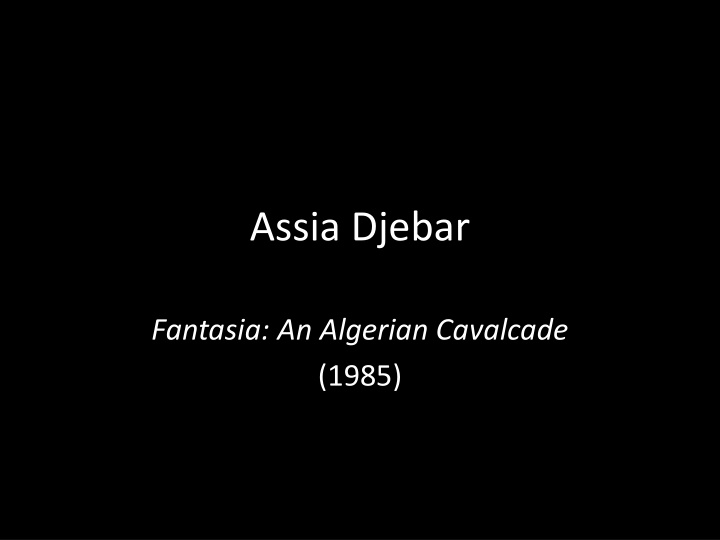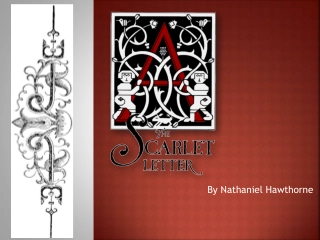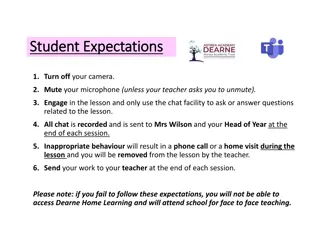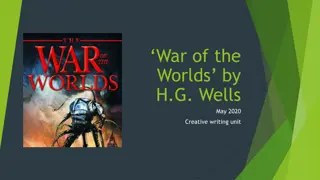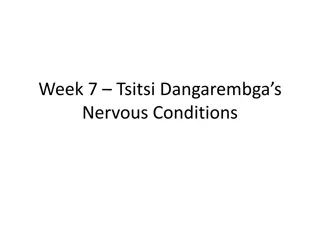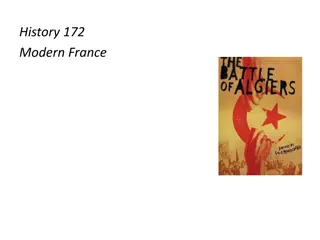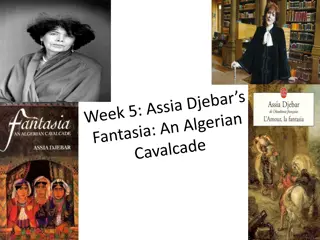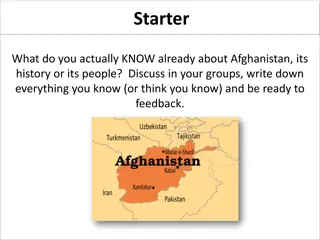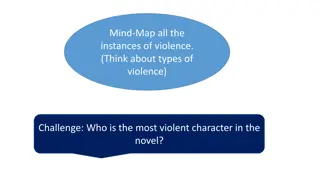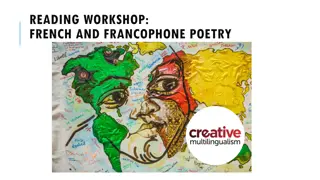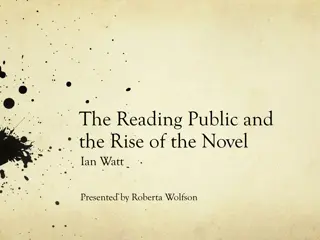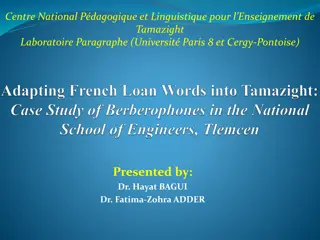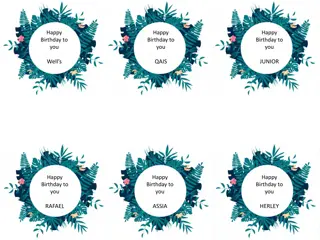Assia Djebar's Novel Fantasia: An Algerian Cavalcade
Delve into Assia Djebar's novel "Fantasia: An Algerian Cavalcade" to uncover its highly experimental structure fusing autobiographical narratives with Algerian history. Discover how the novel reflects on colonial and postcolonial Algeria, reimagining history through personal experiences and hidden narratives, symbolized by the motif of the amputated hand. Explore the polyphonic nature of the narrative and the challenge of writing subaltern histories, offering a complex portrayal of identity and memory.
Download Presentation

Please find below an Image/Link to download the presentation.
The content on the website is provided AS IS for your information and personal use only. It may not be sold, licensed, or shared on other websites without obtaining consent from the author.If you encounter any issues during the download, it is possible that the publisher has removed the file from their server.
You are allowed to download the files provided on this website for personal or commercial use, subject to the condition that they are used lawfully. All files are the property of their respective owners.
The content on the website is provided AS IS for your information and personal use only. It may not be sold, licensed, or shared on other websites without obtaining consent from the author.
E N D
Presentation Transcript
Assia Djebar Fantasia: An Algerian Cavalcade (1985)
Historical Context Colonial and postcolonial Algeria From the capture of Algiers in 1830 to the Algerian War of Independence 1954- 1962 FLN in power Civil war and Islamicisation
Structure of the novel Highly experimental/virtuosic (virtuoso movements of horseback) fusing various genres and modes of representation Polyphonic structure--Musical movement, resembling a symphony (allusion to Beethoven s Fantasia, and the novel s 5 parts) Chapters alternate between autobiographical accounts and Algerian history History and memory
Writing/Righting History Personal experiences (autobiographical voice of the narrator) interwoven with the historical account an inquest into the nature of identity Opening up the archive obscure sources; fragmentary texts; letters, private journals of French painters, generals, bureaucrats, writers, war correspondents; reading Turkish and Arabic memoirs (Part 1) and oral testimony (Part 2) scribblomania French accounts of the conquest of July 1830 P. 45: writing and power The role of women in Algerian history Said documentary
Colonial history as palimpsest Palimpsest: a manuscript, typically of papyrus or parchment, that has been written on more than once, with the earlier writing incompletely erased and often legible Narrator grateful for Pelissier s account (78) Re-reading the chroniclers
Hand/qalam The narrator wants to close the novel by greeting the French painter Eugene Fromentin Hand/qalam: play on words The amputated hand comes to symbolise Algeria, mutilated by a history written by others French historians, writers, artists Algerian women amputated in their desire to write or express themselves
Subaltern history How does one write the history of people (women, peasants, tribals) who have remained silent about their role, their agency, both because they could not write, but also because they were deliberately silenced/mutilated?||
Small voice of history Poetic imagination creating the scene I can imagine ; I slip into the antechamber of this recent past holding my breath in an attempt to overhear everything (8) small voice of history Algerian peasant women: Voice the call of the dead p. 46r Kalam and the severed hand
The question of language Written French versus oral Arabic (father, a teacher at a French primary school; colonizer, school teacher; and mother tongue) thus the language that my father had been at pains for me to learn, serves as a go-between, and from now a double, contradictory sign reigns over my initiation (4) Using the colonizers /father s language Education: I cut myself adrift (5) exile, loss of connection
Writing/unveiling Writing/unveiling prison walls/prohibitions, inhibitions broken; giving voice; making visible; boundaries of decency/indecency To write is to unveil; to enter freedom Letter from the young boy rape (4); Letters to the boy in French a double, contradictory sign (4) French/colonizer language of love and intimacy Reading and writing as subversive acts the motif of the love letter: between public and private
The materiality of words Words materialized: whirling furtively around, about to twine invisible snares around our adolescent bodies ; I had the premonition that in the sleepy, unsuspecting hamlet, an unprecedented women s battle was brewing beneath the surface (13)
Colonization and sexuality controlling bodies, desire through colonization: an obscene copulation (19) The city of Algiers makes her first appearance in the role of Oriental Woman , motionless, mysterious (6) role of Arab women fighting French forces in the 19thc (Barchou: Arab tribes are always accompanied by great numbers of women who had shown the greatest zeal in mutilating their victims (18). P. 18/19: Thus these two Algerian women
Algeria as woman Dominant images of the novel rape and abduction sexualise the colonial representation of Algeria, which becomes, in the final analysis, the female body. If it is on this body that the history of the French conquerors had been written, it is from this body that the decolonization of a people must be written to all the other women whom no word has reached (59)
